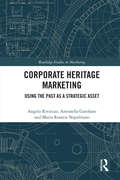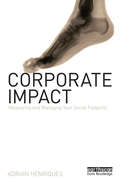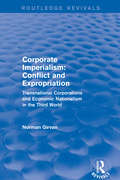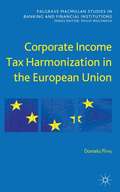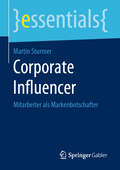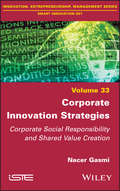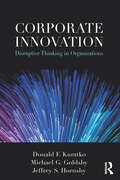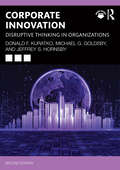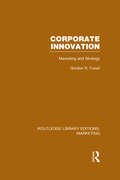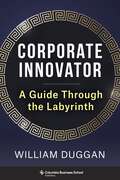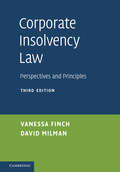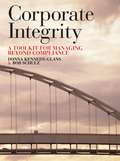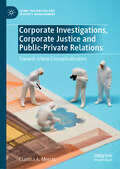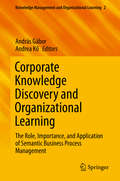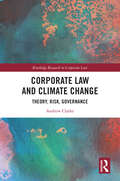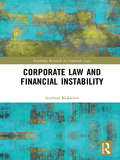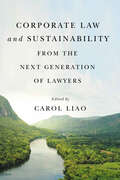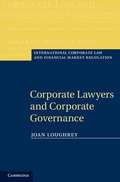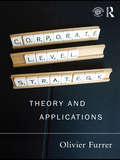- Table View
- List View
Corporate Groups and Shadow Business Practices
by Linn Anker-SørensenThe uniqueness of this book is its conceptualization of a corporate group as a system of interaction, comprised of nodes, links and internal governance tools. This framework can be used to understand what constitutes a group, based on affiliation-linkages. By increasing our perception of group-structuring we can assess the extent to which existing laws address all variables. If the law does not consider certain variables to be used for identifying groups, a case of shadow business may be identified. Group-transparency is a recurring topic on the regulatory agenda. In this book, three legal domains are analysed questioning whether specific amendments have led to increased group-transparency: the control-definition for consolidated accounts, shareholder-transparency in company law, and major holding disclosure in listed companies. This book identifies deficiencies of the law in obtaining its regulatory objective of group-transparency, and proposes an interpretative solution based on Systems Thinking.
Corporate Heritage Marketing: Using the Past as a Strategic Asset (Routledge Studies in Marketing)
by Angelo Riviezzo Antonella Garofano Maria Rosaria NapolitanoCorporate Heritage Marketing introduces the reader to the design and implementation of a heritage marketing strategy. It aims to propose a new and integrated reading of this marketing strategy, both from a theoretical and a managerial perspective. This book sets out to answer key questions, such as: how is it possible to engage all the company's stakeholders by exploiting corporate heritage? It also aims to discuss the basic principles for achieving a successful marriage between marketing and heritage. By highlighting the results of a research focused on 20 Italian companies, the book proposes a model for the development and implementation of a heritage marketing strategy. The nature of this book, being both theoretical and empirical, can contribute to increasing the curiosity and interest towards heritage marketing of both academics and practitioners.
Corporate Imagination Plus
by Jim BandrowskiUnlock the power of creativity and innovation in strategic planning with Jim Bandrowski's transformative five-step process designed to elevate your organization at every level—perfect for readers of You&’re the Boss and Grit.This groundbreaking book was the first to explain how to incorporate creativity and innovation into strategic planning—and motivate your organization to execute new strategies enthusiastically. Pioneering and practical, this book uses hundreds of real-world examples to explain Jim Bandrowski&’s five-step Creative Planning Process. These steps are proven to help a CEO create and implement a company-wide vision or assist division and department managers in setting strategic direction for their unit. Bandrowski shows readers how to innovate in every area of their organization—marketing, new product development, manufacturing, quality, human resources, finance, and customer service—at the corporate, division, department, and project levels. Interviews with corporate executives along with extensive research reveal the creative approaches their companies are using to win, including Apple Computer, Compaq Computer, Charles Schwab, Merck, Circus Circus, General Mills, McKesson Corporation, Gensler Associates, Dolby Laboratories, and many others. Thirty techniques for conceiving strategic breakthroughs are presented along with proven approaches to launching plans, monitoring their rollout, and assuring they are successfully put into action. Conventional strategic and operational planning do little to stimulate imagination. Bandrowski presents countless ways that executives and planning facilitators can blend rigorous strategic analysis with innovative thinking. Strategy development requires creativity. Learn how to: Develop strategic insights that lead to breakthroughs. Unleash your creativity through expansive thinking. Deploy your child, adult, and parent mindsets to innovate. Transform wild ideas into feasible options and then successful strategies. Become a shrewd strategic decision maker. Formulate crystal clear strategic and operational plans. Lead and facilitate teams in achieving strategic innovations. Brand your products and services to insure they drive growth. Reinvent operations to achieve quality breakthroughs and strategically reduce costs. The book&’s concluding section on Corporate Restructuring covers Creative Corporate Planning, Acquisition Bargains, Divesture Coups, and Corporate Turnaround Strategies. If you want to Out-Think and Out-Implement your competition, this book is for you.
Corporate Impact: Measuring and Managing Your Social Footprint
by Adrian HenriquesIt is widely accepted that sustainability has an inescapable social component, but companies find it very hard to understand and measure their social impacts. Why is this? This book, by noted CSR practitioner, consultant and educator Adrian Henriques, provides the first coherent approach to identifying, understanding, measuring and accounting for corporate social impact. Beginning with an analysis of the nature of corporate social impact and the role of the stakeholder, the complex relationship of social impact to economic and environmental impacts is explored. This naturally leads to an examination of the contribution which social impact makes to business practice, profitability and ultimately to global sustainability. The second part of the book assesses the theory and practise of some of the critical measures of social impact which have been developed to date. This includes Social Return on Investment (SROI), local economic impact (LM3) and social capital as well as more established techniques. . It also explores new approaches such as 'social footprinting'. This is rounded out by presentation of a social accounting framework and how this can operate in parallel to standard financial accounting procedures. This volume provides a clear, digestible and practical roadmap for companies wishing to take responsibility for their role in society and improve their internal and external performance.
Corporate Imperialism: Conflict and Expropriation
by Norman GirvanThis title was first published in 1976
Corporate Income Tax Harmonization in the European Union (Palgrave Macmillan Studies in Banking and Financial Institutions)
by Daniela PîrvuThrough the arguments for corporate tax harmonization in the EU and describing the current stage of this process, the legislative rules which are insufficient to solve the many problems implied by the proper functioning of the Single Market, are revealed. The book also exposes the issues involved in the consolidation of the corporate tax base.
Corporate Influencer: Mitarbeiter als Markenbotschafter (essentials)
by Martin SturmerMartin Sturmer zeigt in diesem essential, dass Mitarbeiter die besten Markenbotschafter sind – im Unterschied zu externen Influencern überzeugen Kommunikatoren aus dem eigenen Unternehmen (Corporate Influencer) durch Authentizität, Engagement und Fachwissen. Corporate Influencer haben ein enormes Potenzial: Sie stärken die Markenbekanntheit und steigern die Interaktionsraten mit Kunden und Interessenten. Außerdem verbessern sie die Mitarbeiterbindung und unterstützen den Aufbau einer starken Arbeitgebermarke. Der Autor vermittelt die wichtigsten Methoden und Instrumente für Unternehmen, die selbst ein erfolgreiches Corporate-Influencer-Programm ins Leben rufen wollen.
Corporate Innovation Strategies: Corporate Social Responsibility and Shared Value Creation
by Nacer GasmiCorporate social responsibility (CSR) is simply the maximization of a company's value over time, undertaken because, in the long run, social and environmental problems ultimately become financial problems. The justification for CSR is therefore associated with representing the nature and role of the company, as well as its purpose. Companies therefore regard CSR as a strategic investment that is part of a proactive, resilient, inclusive approach, based on the creation of shared value. This approach is capable of reducing negative societal impacts of their activities, or inducing positive impacts if they sustain a hybrid culture, all the while improving their competitive advantage. This book presents a theoretical development that analyzes the challenges of CSR strategies based on the creation of shared value. Two case studies are presented, analyzing the different forms of social innovation strategies capable of inducing this shared value creation.
Corporate Innovation: Disruptive Thinking in Organizations
by Donald F. Kuratko Jeffrey S. Hornsby Michael G. GoldsbyEffectiveness is the underlying theme for this introduction to disruptive innovation. The book tells the manager, or student, what they need to know in transforming the thinking in an organization to an innovative mindset in the twenty-first century.Corporate Innovation explains the four stages of the innovation process, and demonstrates how to improve skills in the innovation process, and unleash personal innovative abilities. This book also presents ways to assess the organization’s attitudes toward innovation, providing insights into how to diagnose creative and innovative performance problems in the organization. Beginning with an overview of concepts involved with an innovative organization today, this book explores the fundamental aspects of the individual, the organization and the implementation. An I-Organization is a combination of: I-Skills developed within individuals I-Design thinking functions needed to shape innovation I-Teams that emerge from the HR perspective of structuring the appropriate climate I-Solution needed to provide a foundation for implementing any innovative ideas Essential reading for students of corporate innovation, corporate ventures, corporate strategy, or human resources, this book also speaks to the specific needs of active managers charged with the expectation of enhancing the innovative prowess of their organization.Instructors’ outlines, lecture slides, and a test bank round out the ancillary online resources for this title.
Corporate Innovation: Disruptive Thinking in Organizations
by Donald F. Kuratko Jeffrey S. Hornsby Michael G. GoldsbyWhether you want to become a successful innovator within your organization or develop an environment that spawns an innovative mindset, Corporate Innovation, 2nd edition can be helpful to you. Accomplished entrepreneurs create successful new ventures and implement them successfully. To do this consistently takes a blend of entrepreneurship, creativity, innovation, and knowing how to make teams work effectively. The concepts behind corporate innovation mirror many of these same principles.This revised edition will help you develop an understanding of an innovative organization, the specific processes involved in corporate innovation, and how to assess your organization’s readiness for entrepreneurial activity and innovation. It will help you learn how to get more ideas successfully to market and how to write effective innovation plans for the implementation of innovative ideas. As opposed to simply entrepreneurship or technology entrepreneurship, the principal focus of this book is new product and service innovations developed inside existing organizations. What distinguishes structures for innovation from the processes for innovation will be explored. The corporate innovation process chapter examines the various stage gate and other non-linear models in the new product development literature. Finally, since it is about “disruption” in today’s industries, we explore the outcomes that are being accelerated and specify the kinds of metrics that are involved. Corporate Innovation, 2nd edition helps you to understand innovation by explaining the four stages of the innovation process, how to improve your skills in the innovation process, and unleash your personal innovative abilities. In addition, you will find ways to assess the organization’s attitudes toward innovation, giving you insights into how to diagnose creative and innovative performance barriers in the organization.Essential reading for students of corporate innovation, corporate ventures, corporate strategy, or human resources, this book also speaks to the specific needs of active managers charged with the expectation of enhancing the innovative prowess of their organization. Instructors’ outlines, lecture slides, and a test bank round out the ancillary online resources for this title.
Corporate Innovation: Marketing and Strategy (Routledge Library Editions: Marketing)
by Gordon FoxallThis volume is concerned with understanding the factors that determine innovation and its contribution to corporate achievement. It considers the whole range of innovation, consumer and industrial, and both final and intermediate buying behaviour. Although the tenor of the book is towards understanding and evaluation, its ultimate concerns are with the practicalities of marketing and corporate innovation.
Corporate Innovator: A Guide Through the Labyrinth
by William DugganInnovation is a top priority for all kinds of organizations, of all sizes and shapes, throughout the world. But innovation doesn’t happen only at the executive level. People within an organization come up with great ideas that can propel the company forward. All too often, however, would-be innovators find that the organization is unreceptive to their new ideas. They are stymied by bureaucracy, power dynamics, or countless other barriers to innovation. They find themselves lost in a labyrinth that blocks them everywhere they turn.William Duggan—a leading expert on innovation and strategic thinking—offers a guide to navigating the maze from idea to implementation. He provides practical advice on communicating new ideas effectively, getting buy-in from others, winning allies, and overcoming resistance or outright opposition to innovation. Duggan focuses on the strategy and tactics of building support within the organization, exploring the crucial takeaways from research in psychology about how people react to new ideas. This book includes a series of interviews with successful corporate innovators as well as analysis of historical cases that combine lively storytelling with actionable insights. For anyone in an organization who has been frustrated with the lack of innovation, Corporate Innovator delivers an essential roadmap for going from idea to action.
Corporate Insolvency Law: Perspectives and Principles
by Vanessa Finch David MilmanThe first edition of Corporate Insolvency Law proposed a fundamentally revised concept of insolvency law, intended to serve corporate as well as broader social ends. This second edition takes on board a host of changes that have subsequently reshaped insolvency law and practice, notably the consolidation of the rescue culture in the UK, the rise of the pre-packaged administration and the substantial replacement of administrative receivership with administration. It also considers the implications of recent and dramatic changes in the provision and trading of credit, the movement of an increasing amount of insolvency work to the pre-formal insolvency stage of corporate affairs and the arrival, on the insolvency scene, of a new cadre of specialists in corporate turnaround. Looking to the future, Vanessa Finch argues that changes of approach are needed if insolvency law is to develop with coherence and purpose, and she offers a framework for such an approach. "
Corporate Integrity: A Toolkit for Managing Beyond Compliance
by Donna Kennedy-Glans Robert SchulzHow good companies build a culture of integrity In the present environment of corporate governance brought on by high-profile executive scandals, this book makes a strong case for encouraging business leaders to manage beyond compliance. Achieving the bare minimum of compliance isn't enough. By making corporate responsibility and integrity a strategic priority-rather than something companies are forced to comply with-companies can realize tangible financial returns and benefits. This book provides practical advice, effective tools, and time-tested best practices for approaching corporate integrity strategically and managing an integrity program on a day-to-day basis. There is a growing realization that compliance with the rules is only a minimum standard of performance, and an increasing demand from stakeholders at every level — shareholders, employees, customers along the entire supply chain, consumers, advocacy groups, and the local community at large — for more transparency and accountability from corporations. But most businesses have little experience and few tools to deal with the urgent demand to increase corporate responsibility. Corporate Integrity provides practical tools and proven processes to manage complex integrity dilemmas and support implementation: Explains how to create a culture of integrity in your organization and how to motivate the appropriate corporate behaviors. Coverage includes: How to assess and measure integrity; how to align corporate integrity commitments and actions; how to design and implement dependable and strategic corporate accountability systems and processes; how to develop corporate integrity standards and report on them, and much more. Includes a wealth of practical business tools and best practices that readers can apply to improve the level of corporate integrity in their own company. Features three detailed case studies and numerous other examples that illustrate corporate integrity dilemmas and solutions in action. Shows how managing corporate responsibility strategically and proactively can go beyond a mere public relations exercise to foster a corporate "win" in the court of popular opinion and in the marketplace. Bridges the gaps between corporations, governments, employees, interest groups, and consumers. Offers tools and solutions that apply to both for-profit corporations and non-profit organizations.
Corporate Inversions: Stanley Works and the Lure of Tax Havens
by Mihir A. Desai Mark F. Veblen James R. Hines Jr.In response to Stanley Work's announcement that it is moving to Bermuda--and the associated jump in market value--a major competitor sets out to determine how the market is valuing the consequences of moving to a tax haven and whether his company should invert to a tax haven. In particular, the competitor's CFO needs to attribute Stanley's stock price movements across several dimensions of potential tax savings (tax savings on foreign operations and on interest payments) to see if there might be something else at play (earnings stripping). In the process, the mechanics and incentives created by the international tax regime are illustrated. To obtain executable spreadsheets (courseware), please contact our customer service department at custserv@hbsp.harvard.edu.
Corporate Investigations, Corporate Justice and Public-Private Relations: Towards a New Conceptualisation (Crime Prevention and Security Management)
by Clarissa A. MeertsThis book seeks to understand the investigation and settlement of employer/employee disputes within companies. It argues that there is effectively no democratic knowledge about, or control over, corporate security, due to companies' preference for private, out-of-court settlements when faced with norm violations raised by employees. This book fills the knowledge gap by providing an overview of the corporate security sector including legal frameworks and an analysis of the role and powers of private investigative services, inhouse security, forensic accountants and forensic legal investigators. It draws on close observation, case studies and interviews with practitioners in and around the industry. Corporate Investigations, Corporate Justice and Public-Private Relations also looks at public-private relationships in this sector to propose policy remedies applicable to all corporate security providers, regardless of the disparate professional backgrounds and skill-sets of their staff.
Corporate Irresponsibility: America's Newest Export
by Lawrence E. MitchellCritique of modern business practices.
Corporate Islam
by Patricia Sloane-WhiteCompelling and original, this book offers a unique insight into the modern Islamic corporation, revealing how power, relationships, individual identities, gender roles, and practices - and often massive financial resources - are mobilized on behalf of Islam. Focusing on Muslims in Malaysia, Patricia Sloane-White argues that sharia principles in the region's Islamic economy produce a version of Islam that is increasingly conservative, financially and fiscally powerful, and committed to social control over Muslim and non-Muslim public and private lives. Packed with fascinating details, the book is essential reading for anyone with an interest in Islamic politics and culture in modern life.
Corporate Knowledge Discovery and Organizational Learning: The Role, Importance, and Application of Semantic Business Process Management (Knowledge Management and Organizational Learning #2)
by András Gábor Andrea KőThis book investigates organizational learning from a variety ofinformation processing perspectives. Continuous change and complexity inregulatory, social and economic environments are increasingly forcingorganizations and their employees to acquire the necessary job-specificknowledge at the right time and in the right format. Though many regulatorydocuments are now available in digital form, their complexity and diversitymake identifying the relevant elements for a particular context a challenging task. In such scenarios, business processes tend to be important sources ofknowledge, containing rich but in many cases embedded, hidden knowledge. This book discusses the possible connection between businessprocess models and corporate knowledge assets; knowledge extraction approachesbased on organizational processes; developing and maintaining corporateknowledge bases; and semantic business process management and its relation toorganizational learning approaches. The individual chapters reveal the differentelements of a knowledge management solution designed to extract, organize andpreserve the knowledge embedded in business processes so as to: enrichorganizational knowledge bases in a systematic and controlled way, supportemployees in acquiring job role-specific knowledge, promote organizationallearning, and steer human capital investment. All of these topics are analyzedon the basis of real-world cases from the domains of insurance, food safety,innovation, and funding.
Corporate Law and Climate Change: Theory, Risk, Governance (Routledge Research in Corporate Law)
by Andrew ClarkeThis book provides an analysis of the impact of the climate crisis on corporate law and theory in the coming decades as the world seeks to meet the target of net zero carbon emissions by 2050.Net zero targets are a particular challenge for an economy such as Australia which has a historical reliance on fossil fuels, and powerful interests arguing for the continued use of coal and gas. The book examines four recent corporate case studies in Australia. The first two follow the Adani group of companies and coal in Queensland and Rio Tinto and the destruction of ancient rock shelters in the midst of iron ore mining in WA. The book then covers the pension fund member Mark McVeigh, issuing proceedings against REST super in relation to long-run investment decisions and the need to take into account climate risk. Finally, it discusses Sharma, a representative action taken by school children against the Federal government in relation to expansion plans in relation to fossil fuels allegingbreach of the duty of care. These case studies highlight some of the key trends and challenges in the intersection between corporate activity and the need to account for climate risk and adaptation, with Australia as a G20 economy having much to contribute to the global debate.The book will be of interest to students and researchers in the field of climate and environmental law, as well as corporate law and theory.
Corporate Law and Financial Instability (Routledge Research in Corporate Law)
by Andreas KokkinisVirtually all large banks and other financial institutions in the UK and internationally are public limited liability companies whose shares are listed on one or several stock exchanges. As such, their corporate governance and, in particular, the incentives faced by their directors and senior managers are to a significant extent determined by corporate and securities law rules such as directors’ duties, directors’ liability in insolvency, takeover regulation, disclosure obligations, shareholder rights and rules on executive remuneration. At the same time, systemically important financial institutions in the UK are licensed, regulated and supervised by the Prudential Regulation Authority (PRA). This book explores the relationship between, on the one hand, the broader corporate law, corporate governance and securities law framework and, on the other, the prudential regulatory framework. Although the book’s main focus is on UK law, much of the policy argumentation is relevant globally and therefore appropriate international comparisons are drawn, and analysis of EU law and regulation is included. The book argues that the corporate law regime, which focuses on shareholder empowerment and profit maximisation, operates as an antithesis to prudential regulatory objectives thus undermining the safety and soundness of banks and other financial institutions by encouraging risky behaviour that may be in the best interests of their shareholders, but is clearly not in the public interest.
Corporate Law and Sustainability from the Next Generation of Lawyers
by Carol LiaoMillennials have come of age in an era when environmental and social crises have defined much of their adult lives, as has the recurrent message that time is of the essence. Future generations will bear the greatest burden created by climate change, pandemics, and inequality, but often they are not in positions of power to make impactful decisions about it.This book gives voice to young lawyers offering new critical perspectives in the burgeoning field of corporate law and sustainability. Climate change is an intergenerational crisis, and the solutions and path forward must include intergenerational voices. Millennials are coming of age at a critical juncture in our climate and corporate history, and their perspectives stand apart from those who have been trained into myopic views of what constitutes change. These essays challenge the status quo across a number of pressing topics, including executive compensation, board diversity, decolonialization, crowdfunding, social media risk, corporate lobbying, shareholder activism, tax avoidance, global supply chain management, and human rights, written with a level of thoughtfulness and urgency that demands attention from policymakers and scholars alike.Edited by Carol Liao, a leading expert in the field, and with a foreword by author and filmmaker of The Corporation and The New Corporation Joel Bakan, this book offers timeless research from a diverse group of young lawyers calling for bona fide corporate accountability within legal and regulatory frameworks, including innovative ideas for reform.
Corporate Law and the Theory of the Firm: Reconstructing Corporations, Shareholders, Directors, Owners, and Investors (The Economics of Legal Relationships)
by Wm. Dennis HuberDozens of judicial opinions have held that shareholders own corporations, that directors are agents of shareholders, and even that directors are trustees of shareholders’ property. Yet, until now, it has never been proven. These doctrines rest on unsubstantiated assumptions. In this book the author performs a rigorous, systematic analysis of common law, contract law, property law, agency law, partnership law, trust law, and corporate statutory law using judicial rulings that prove shareholders do not own corporations, that there is no separation of ownership and control, directors are not agents of shareholders, and shareholders are not investors in corporations. Furthermore, the author proves the theory of the firm, which is founded on the separation of ownership and control and directors as agents of shareholders, promotes an agenda that wilfully ignores fundamental property law and agency law. However, since shareholders do not own the corporation, and directors are not agents of shareholders, the theory of the firm collapses. The book corrects decades of confusion and misguided research in corporate law and the economic theory of the firm and will allow readers to understand how property law, agency law, and economics contradict each other when applied to corporate law. It will appeal to researchers and upper-level and graduate students in economics, finance, accounting, law, and sociology, as well as attorneys and accountants.
Corporate Lawyers and Corporate Governance
by Joan LoughreyThis assessment of the corporate governance role of corporate lawyers in the UK analyses the extent to which lawyers can and should act as gatekeepers, counsellors and reputational intermediaries. Focusing on external and in-house lawyers' roles in both dispersed share-ownership and owner-managed companies, Joan Loughrey highlights the conflicts of interest that are endemic in corporate representation and examines how lawyers should respond when corporate agents provide instructions contrary to the company client's interests. She also considers the legitimacy of 'creative compliance', the ethical arguments for and against lawyers prioritising the public interest over their clients' interests, and their exposure to liability if they fail to perform a corporate governance role. Finally, she considers whether the reforms to the legal profession will promote the lawyer's corporate governance role and advances suggestions for reform.
Corporate Level Strategy: Theory and Applications
by Olivier FurrerThe challenges faced by diversified corporations – firms that operate in more than one industry or market – have changed over the years. There is now a wide range of strategies, including corporate level strategy, to add competitive advantage to these corporations as a whole. In Corporate Level Strategy, Furrer guides the reader in developing the ability to consider the impact of change and other important environmental forces on the opportunities for establishing and sustaining corporate advantage by exploring three fundamental questions: Why are some companies highly specialized, while others embrace a wide range of products, markets and activities? What is the link between scope and performance? What can we say about the management of multi-business firms in terms of structure, management systems and leadership? Replete with case studies and international examples, and featuring a companion website, this incisive book is an ideal read for advanced undergraduate and postgraduate students.

